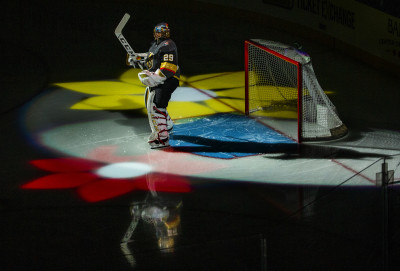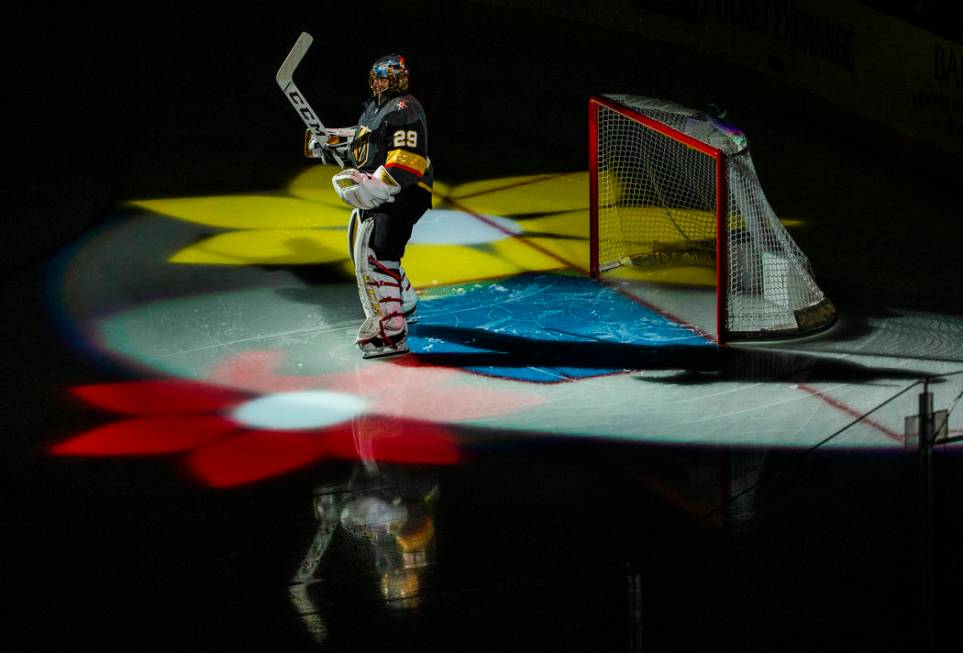Marc-Andre Fleury shows no signs of aging on 35th birthday


The only logical place to start is the save, since that’s also the freshest example of Marc-Andre Fleury taking a blowtorch to conventional thinking about goaltending.
By now, it doesn’t need much description. Fleury made a Superman leap across his crease, and in a single bound, gloved a shot by Toronto’s Nic Petan to preserve the Golden Knights’ 4-2 victory nine days ago.
“It’s a career-defining moment from someone who has so many,” said Knights TV studio analyst and former NHL goaltender Mike McKenna. “It was tracking, it was explosiveness, rotation. It was every goalie code word, and it was the ability to have the confidence in himself to make that read.”
All that is true. From a technical standpoint.
Symbolically, though, Fleury’s diving save represents so much more.
“That was an Ozzie Smith-esque play. A young Derek Jeter-esque play by a goalie, on skates, in goalie equipment, on ice,” NHL Network analyst Kevin Weekes said. “I think that save probably answers a lot of your questions in that there’s no diminishing of athleticism of Marc-Andre Fleury.”
Fleury turned 35 on Thursday, the age when statistical research indicates goaltenders are supposed to begin their decline, not go airborne like a shortstop diving up the middle and snag a fluttering puck out of the air.
But the last netminder to be drafted No. 1 overall remains an anomaly.
While his peers begin to skate off into retirement, Fleury shoulders the workload for a team with Stanley Cup aspirations, still producing acrobatic saves in his 16th season.
“You feel it more in the mornings, sometimes when you wake up and stuff,” Fleury said. “A little more stiff, and you’ve got to do more stuff to stay in game shape and game ready. But it’s OK. It’s part of the game. I don’t mind it. I have so much fun still playing in practice and the games. It’s all worth it.”
‘Father Time gets everybody’
The effects of aging on a goaltender’s performance have been extensively researched, with Hockey-Graphs.com’s 2014 study frequently cited as the most thorough and reliable.
Using data of every goalie from 1996-97 through the 2013-14 season, its model’s aging curve showed a .004 drop in save percentage each season from 35 until 38. From then on, save percentages go down .005 per season until age 40.
That means a 35-year-old goaltender with an above-average .920 save percentage is projected to be at an acceptable .912 in two seasons and a subpar .898 by the time they turn 40.
Fleury was at .919 through Wednesday’s game against Nashville and has a career .913 save percentage.
“When you get to a certain age, if you’re not in the very top percent of goaltenders in the world, you don’t get the benefit of the doubt anymore because of those statistics that suggest that you’re probably going to fall away,” said McKenna, who retired after last season at age 36. “Those guys tend to get shuffled out as contracts come about with younger players.”
The average age of starting goaltenders in the NHL this season is 29.6 years, though that number trends upward if Ottawa’s Craig Anderson, 38, and Detroit’s Jimmy Howard, 35, are calculated rather than their younger partner.
Fleury joins 37-year-old Pekka Rinne of Nashville, Edmonton’s Mike Smith (37) and the New York Rangers’ Henrik Lundqvist (37) as the only No. 1 goalies in the NHL who are 35 or older. Of the latter trio, Smith is alone in producing close to his career average in goals against and save percentage this season.
But Fleury may be one of the outliers capable of playing well in his mid- to late-30s.
“As goaltenders get older, sometimes you’ll see little cracks in the foundation of their game,” McKenna said. “Some guys will go by the wayside because they haven’t adapted. They haven’t modernized. The game ages them out. And that’s not the case (with Fleury).”
Fleury blends the butterfly technique, when goaltenders drop to their knees to cover the lower part of the net, with a stand-up style that relies on his superior skating, athleticism, flexibility and what Weekes calls his “super computer,” or ability to read the play.
That hybrid style is less taxing physically on the hips and lends itself to playing at a higher level longer, according to McKenna and Weekes.
Since 2015-16, Fleury is 13th among goaltenders in minutes played, missing time for at least three concussions while also handing the reins in Pittsburgh to Matt Murray.
But that also has helped keep the mileage down on his 185-pound body, and he’s avoided any major structural problems such as groin, hamstring or hip injuries during his career.
Knights coach Gerard Gallant and general manager Kelly McCrimmon publicly stated that they would like to use Fleury less after he appeared in 61 games last season. He’s on pace for 57 starts.
“Right now, part of Flower’s longevity and the team’s success is really going to be predicated not on Flower, because you know what he’s going to give you, but on Malcolm (Subban) staying healthy and being able to play a lot of those games to keep Flower fresh,” Weekes said.
“Father Time gets everybody, but it gets everybody at different times. For the Flower, it hasn’t gotten him yet.”
Window of opportunity
The Knights also believe Fleury can defy the analytics. He’s in the first year of a contract that runs through 2021-22 when he will be 37 and makes him the fourth-highest paid player at his position with a $7 million annual average value.
“Goaltenders can play longer than most of the positions,” president of hockey operations George McPhee said in July 2018 at the time of the signing. “Were he one of the bigger, heavier goaltenders who relies on sort of the hit-me approach, we’d be more concerned. He relies on talent and quickness.”
Weekes, who played 348 NHL games over 11 seasons, once told Fleury he would join Hall of Famers Martin Brodeur and Patrick Roy in the 500-win club.
Fleury has 450 career victories and is four shy of tying Curtis Joseph for sixth place all time. He could surpass 500 wins before the end of next season, depending on health and how many starts he gets.
Lundqvist, whom the Knights could face on their upcoming road trip, is fifth with 455 wins.
“Like when he does his poke-checks and stuff, the confidence he has and the (guts) that he has to do, it’s just great,” Subban said of Fleury. “That’s what makes him such a great goaltender and a goaltender the kids look up to and we all look up to watching him. His compete level and his ability to make those saves out of sheer compete and battle.”
In 19 appearances, Fleury is 11-6-2 with a 2.54 goals-against average and 6.42 goals saved above average, which ranks 12th in the league, according to NaturalStatTrick.
His .853 save percentage on high-danger shots in all situations is a career high and well above the .791 he posted last season.
And he shows no signs of slowing down, posting quality starts (save percentage above average save percentage for the season) 58 percent of the time, which is ahead of his career mark of 55 percent and the league average of 53 percent.
“I feel like with age maybe you get a little smarter, you get more experienced. You read the plays better. So, sometimes you’re maybe not as fast, but you know where to be or what to do a little better,” Fleury said.
“I think you’re always learning and seeing things you haven’t seen before. But maybe now the body is still going, it’s still good, so I’ve got to take advantage of it because you don’t know how long that’s going to last. I know I’m toward the end of my career, and I’ve got to make the most out of it while I can and try to win as much as I can.”
More Golden Knights: Follow reviewjournal.com/
Contact David Schoen at dschoen@reviewjournal.com or 702-387-5203. Follow @DavidSchoenLVRJ on Twitter.